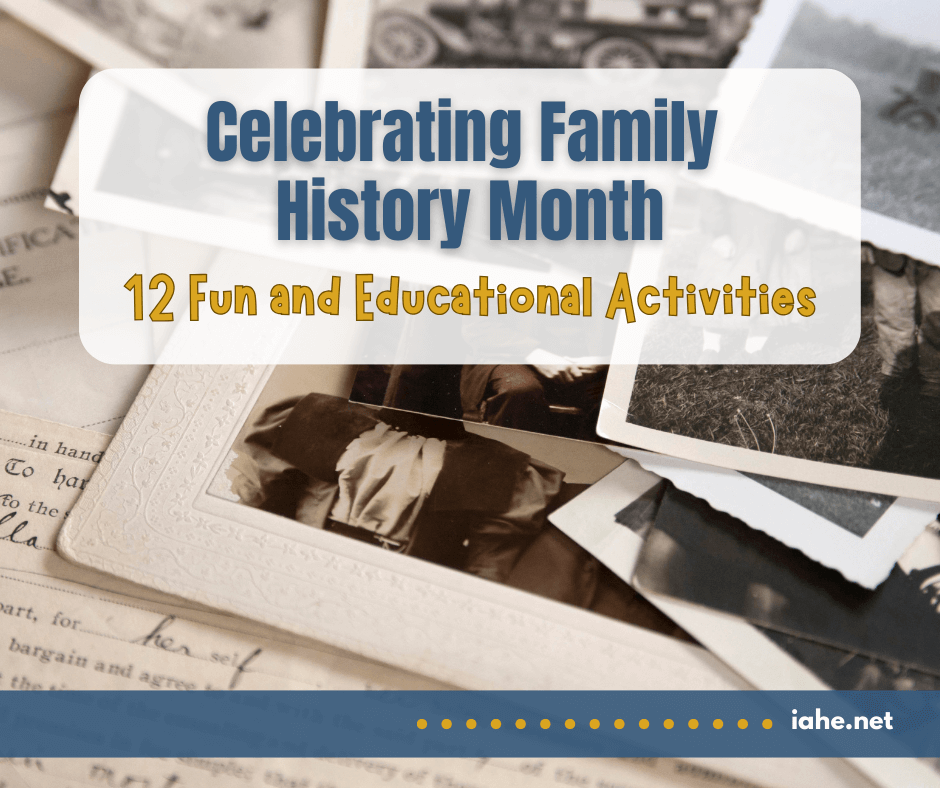
October is Family History Month, a time to reflect on our roots, celebrate our heritage, and engage in meaningful conversations with family members about the past. For homeschooling families, this month offers a perfect opportunity to incorporate history, storytelling, and creativity into your curriculum.
Established in 2001 following the tragic events of 9/11, the United States Senate passed a bill that includes a long list of reasons why October should be Family History Month, including this statement:
Whereas individuals learn about their ancestors who worked so hard and sacrificed so much, their commitment to honor their ancestors’ memory by doing good is increased; Whereas interest in our personal family history transcends all cultural and religious affiliations…
- Senate of the United States
LEARN MORE
- Homeschool Indiana Podcast Episode 24: Celebrating Family History Month with The Genealogy Center’s Curt Witcher
- Family History Month Brochure, by The Genealogy Center
- Celebrate Family History Month, by the National Genealogical Society
Here are 12 fun and educational activities to help your children explore their family history while learning valuable skills along the way.
1. Create a Family Tree
Start with the basics by having your children create a family tree. This can be an artistic project where they use large poster boards, craft supplies, or digital tools to map out your family lineage. Encourage them to gather information from relatives and include interesting facts about each person. This activity not only helps them learn about their immediate family but also introduces them to names and stories from previous generations.
2. Conduct Interviews
Teach your children the art of interviewing by preparing a list of questions to ask family members. This could include inquiries about childhood memories, family traditions, and significant life events. Encourage them to record the interviews (with permission) for future reference. This practice helps develop communication skills and reinforces the importance of listening. Consider creating a family archive where these interviews can be stored for future generations to enjoy.
3. Family History Timeline
Have your children create a timeline highlighting important events in your family’s history. They can include births, marriages, and significant milestones. This can be done on paper or digitally, using timelines software or apps. Visualizing the passage of time helps children understand their family’s story and how it connects to broader historical events. You might also include world events that occurred during those family milestones to provide context.
4. Cultural Heritage Day
Dedicate a day to celebrate your family’s cultural heritage. Prepare traditional dishes, dress in culturally significant attire, and share stories about your ancestors’ customs and traditions. This can also include learning a few words or phrases in a language spoken by your ancestors. You could extend this to include cultural games, music, or dances, providing a well-rounded experience that engages all senses.
5. Photo Album Project
Gather family photos from different generations and create a family photo album. Encourage your children to write captions or stories for each image, explaining who is in the picture and what the occasion was. This project not only serves as a visual representation of your family history but also enhances your children’s writing and narrative skills. Consider creating a digital version as well, using photo-editing software to enhance and organize the images.
6. Genealogy Research
Introduce your children to genealogy websites and resources. Tools like Ancestry.com, FamilySearch.org, or MyHeritage can be invaluable in helping them research their ancestry and discover their family’s migration patterns, occupations, and historical contexts. This can be an engaging way to incorporate technology into your studies. Encourage them to analyze the information critically, discussing how historical events may have shaped their ancestors’ lives.
7. Write a Family History Book
Encourage your children to write a book about your family history. They can combine their research, interviews, and stories into a cohesive narrative. This project will enhance their writing skills and deepen their understanding of family connections. You could help them organize the book into chapters, focusing on different branches of the family or significant themes. Consider self-publishing the book, so it can be shared with family members.
8. Create a Family Recipe Book
Compile family recipes that have been passed down through generations. Have your children help in the kitchen to prepare some of these dishes. This activity not only teaches cooking skills but also reinforces the importance of family traditions. Encourage them to write down the stories behind each recipe, such as who it was passed down from and the occasions it was made for. You could even host a family dinner featuring these dishes to celebrate your culinary heritage.
9. Family History Scavenger Hunt
Organize a scavenger hunt that connects to your family history. Create clues that lead to important family locations or items, such as heirlooms or photographs. This can be a fun way to get active while learning about your heritage. You could also use technology, such as QR codes, to lead them to online resources or family stories. This interactive approach keeps children engaged and excited about discovering their family’s past.
10. Storytelling Session
Host a storytelling session where family members share their favorite memories or tales from their own childhoods. Encourage your children to ask questions and engage with the stories, fostering a connection between generations. You can enhance this activity by incorporating props or visual aids to make the stories more vivid. This can also be a great way to practice public speaking, as children can take turns sharing their own stories.
11. Create a Family History Presentation
Have your children prepare a presentation about what they’ve learned. They can use visuals to share their findings with the family, enhancing their public speaking skills.
12. Explore Local History
Visit local historical sites or museums related to your family’s history. This helps children understand their ancestry in a broader historical context.
Family History Month is an ideal opportunity for homeschool families to connect with their roots. By engaging in these activities, you’ll not only enrich your children’s understanding of their heritage but also create cherished family memories. Embrace the journey of discovery and celebrate the unique stories that define your family!
